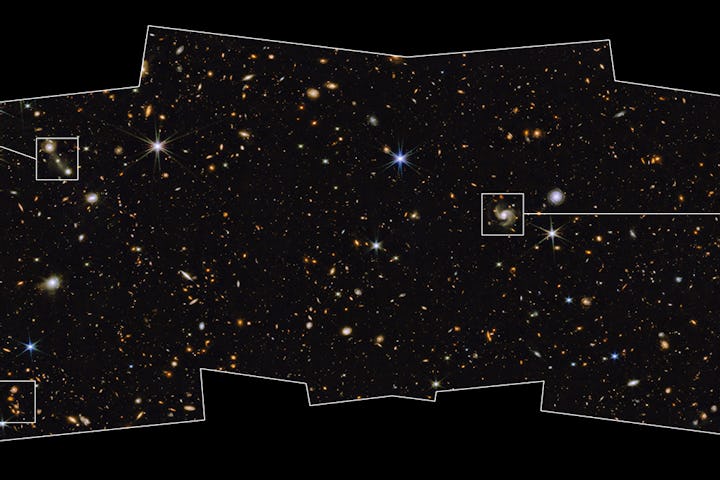Astounding JWST Photo Shows Strip Of Galaxies Like Never Before Seen — Literally
This week, NASA released a new image from the James Webb Space Telescope (JWST) showing a strip of galaxies in a way we’ve never seen before.

This week, NASA released yet another stunning image from the James Webb Space Telescope (JWST) showing a strip of galaxies — the North Ecliptic Pole — in a way we’ve never seen before.
The new image comes courtesy of the agency’s “Prime Extragalactic Areas for Reionization and Lensing Science” (PEARLS) research program. PEARLS aims to study the oldest galaxies in the universe and learn how stars are developed and galaxies are born.
The JWST is helping continue PEARLS researchers gather data, and currently, the team is focusing on the constellation of Draco. The specific region captured in the newest groundbreaking JWST image is known as the North Ecliptic Pole.
“The stunning image quality of Webb is truly out of this world. To catch a glimpse of very rare galaxies at the dawn of cosmic time, we need deep imaging over a large area,” Space Telescope Science Institute (STScI) astronomer Anton Kaekemoer said when explaining the significance of the image.
And with this new technology from the JWST, specifically its Near-Infrared Camera (NIRCam), researchers can see the galaxy like never before — literally.
Can you explain what we see in this photo like we’re 5 years old?
“There are many objects that I never thought we would actually be able to see [that are in this image] including individual globular clusters around distant elliptical galaxies, knots of star formation within spiral galaxies, and thousands of faint galaxies in the background,” research assistant James Summer said.
This image is actually small — a fraction of the size of the galaxy, only measuring 2% of the area covered by the full moon. That might seem small, but it’s an enormous image for one telescope to capture, particularly in such good detail and with such depth.
The image combines eight different colors of infrared light and various exposures that can be picked up with the NIRCam and ultraviolet filters from NASA’s Hubble Space Telescope in three filters.
These various filters allow the researchers to see details in a way that’s not been possible before. The Hubble Telescope yields purple, blue, and deep blue colors, while the JWST yields cyan, three shades of green, two yellows, orange, and red.
The image also shows the spectra of light in the image by using the Near-Infrared Imager and Slitless Spectrograph (NIRISS), which will allow researchers to measure distance in those ancient galaxies.
“This image represents a portion of the full PEARLS field, which will be about four times larger,” NASA explains. “Thousands of galaxies over an enormous range in distance and time are seen in exquisite detail, many for the first time. Light from the most distant galaxies has traveled almost 13.5 billion years to reach us.”
Researchers are thrilled with the image and results, not only because they’re able to see incredible new details, but also because the image highlights the discoveries yet to come.
“I hope that this field will be monitored throughout the Webb mission to reveal objects that move, vary in brightness, or briefly flare up,” said Rolf Jansen, Research Scientist at ASU and a PEARLS co-investigator.
“Such monitoring will enable the discovery of time-variable objects like distant exploding supernovae and bright accretion gas around black holes in active galaxies, which should be detectable to larger distances than ever before,” Kaekemoer added.
This article was originally published on